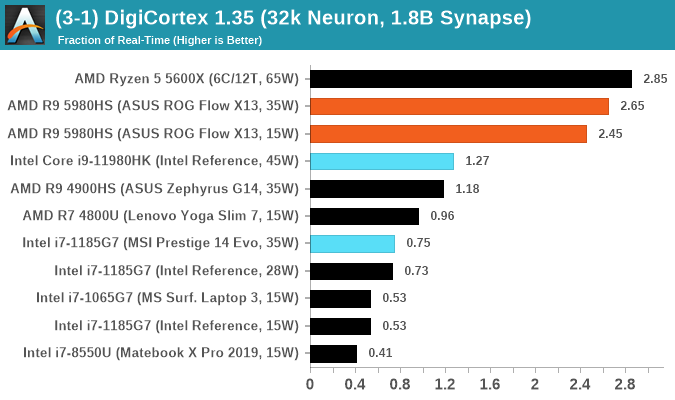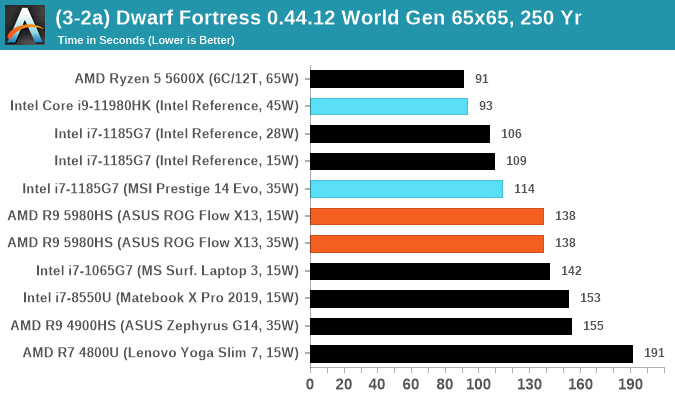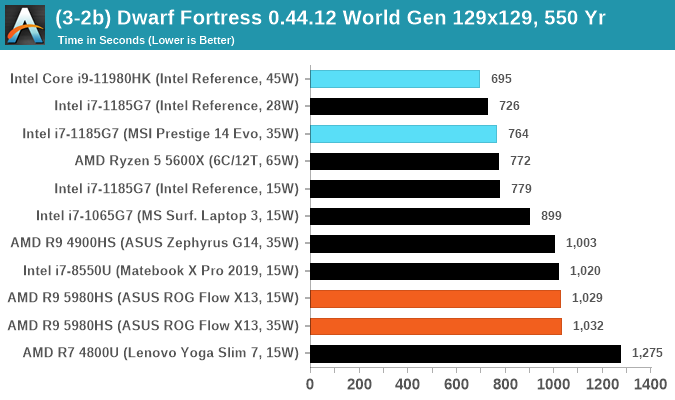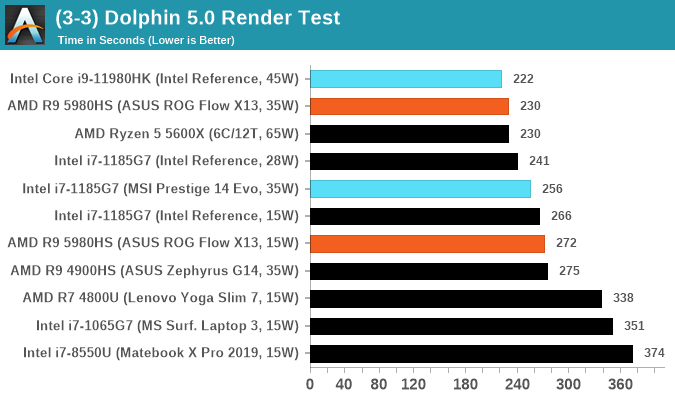Intel 11th Generation Core Tiger Lake-H Performance Review: Fast and Power Hungry
by Brett Howse & Andrei Frumusanu on May 17, 2021 9:00 AM EST- Posted in
- CPUs
- Intel
- 10nm
- Willow Cove
- SuperFin
- 11th Gen
- Tiger Lake-H
CPU Tests: Simulation
Simulation and Science have a lot of overlap in the benchmarking world, however for this distinction we’re separating into two segments mostly based on the utility of the resulting data. The benchmarks that fall under Science have a distinct use for the data they output – in our Simulation section, these act more like synthetics but at some level are still trying to simulate a given environment.
DigiCortex v1.35: link
DigiCortex is a pet project for the visualization of neuron and synapse activity in the brain. The software comes with a variety of benchmark modes, and we take the small benchmark which runs a 32k neuron/1.8B synapse simulation, similar to a small slug.
The results on the output are given as a fraction of whether the system can simulate in real-time, so anything above a value of one is suitable for real-time work. The benchmark offers a 'no firing synapse' mode, which in essence detects DRAM and bus speed, however we take the firing mode which adds CPU work with every firing.
The software originally shipped with a benchmark that recorded the first few cycles and output a result. So while fast multi-threaded processors this made the benchmark last less than a few seconds, slow dual-core processors could be running for almost an hour. There is also the issue of DigiCortex starting with a base neuron/synapse map in ‘off mode’, giving a high result in the first few cycles as none of the nodes are currently active. We found that the performance settles down into a steady state after a while (when the model is actively in use), so we asked the author to allow for a ‘warm-up’ phase and for the benchmark to be the average over a second sample time.
For our test, we give the benchmark 20000 cycles to warm up and then take the data over the next 10000 cycles seconds for the test – on a modern processor this takes 30 seconds and 150 seconds respectively. This is then repeated a minimum of 10 times, with the first three results rejected. Results are shown as a multiple of real-time calculation.

Dwarf Fortress 0.44.12: Link
Another long standing request for our benchmark suite has been Dwarf Fortress, a popular management/roguelike indie video game, first launched in 2006 and still being regularly updated today, aiming for a Steam launch sometime in the future.
Emulating the ASCII interfaces of old, this title is a rather complex beast, which can generate environments subject to millennia of rule, famous faces, peasants, and key historical figures and events. The further you get into the game, depending on the size of the world, the slower it becomes as it has to simulate more famous people, more world events, and the natural way that humanoid creatures take over an environment. Like some kind of virus.
For our test we’re using DFMark. DFMark is a benchmark built by vorsgren on the Bay12Forums that gives two different modes built on DFHack: world generation and embark. These tests can be configured, but range anywhere from 3 minutes to several hours. After analyzing the test, we ended up going for three different world generation sizes:
- Small, a 65x65 world with 250 years, 10 civilizations and 4 megabeasts
- Medium, a 127x127 world with 550 years, 10 civilizations and 4 megabeasts
- Large, a 257x257 world with 550 years, 40 civilizations and 10 megabeasts
DFMark outputs the time to run any given test, so this is what we use for the output. We loop the small test for as many times possible in 10 minutes, the medium test for as many times in 30 minutes, and the large test for as many times in an hour.


Dolphin v5.0 Emulation: Link
Many emulators are often bound by single thread CPU performance, and general reports tended to suggest that Haswell provided a significant boost to emulator performance. This benchmark runs a Wii program that ray traces a complex 3D scene inside the Dolphin Wii emulator. Performance on this benchmark is a good proxy of the speed of Dolphin CPU emulation, which is an intensive single core task using most aspects of a CPU. Results are given in seconds, where the Wii itself scores 1051 seconds.













229 Comments
View All Comments
Alistair - Monday, May 17, 2021 - link
no, that's not right, Tiger Lake is mainly clock speed improvements, not IPC, running Tiger Lake or Comet Lake in a desktop at the same 4.8GHZ all core would get you almost exactly the same performanceheickelrrx - Monday, May 17, 2021 - link
are u drunk?laduran - Tuesday, May 18, 2021 - link
Nomode_13h - Tuesday, May 18, 2021 - link
> Tiger Lake is mainly clock speed improvements, not IPC, running Tiger Lake or Comet Lake> in a desktop at the same 4.8GHZ all core would get you almost exactly the same performance
You're confusing Comet Lake with Ice Lake. IPC of Tiger Lake isn't much improved above that of Ice Lake.
Qasar - Wednesday, May 19, 2021 - link
can you blame him ? its time intel started using different names for their cpus.mode_13h - Thursday, May 20, 2021 - link
I didn't mean that in a pointed way. If anything, I thought it would partially validate the statement.And yes, I wish Intel would've left the Lakes behind with 14 nm, but I guess there are just too many "lake" names for them to part with it for the mere sake of naming consistency. More annoyingly, they're even using "lake" names for some things that aren't CPUs.
Qasar - Thursday, May 20, 2021 - link
it seems they are staying with lake and cove names so unless you are using a slide ruler and a decoder ring, you have no idea which cpu is what :-) i gave up trying to keep track of their names are which cpu line a while ago.mode_13h - Friday, May 21, 2021 - link
> it seems they are staying with lake and cove namesSapphire Rapids is the next server CPU. Also, the little cores seem to be Monts, while the big cores are Coves.
I think the biggest groaner is "Lakefield", which is that mobile CPU with one big core, 4 little cores, and a chunk of eDRAM. MS used it in a Surface model.
Qasar - Friday, May 21, 2021 - link
mode_13h, still doesnt change the fact that the names intel gives its cpus, are confusing has he double hockey sticks :-)mode_13h - Sunday, May 23, 2021 - link
Oh, for sure. It was so nice when *Bridge = LGA 1155, *Well = LGA 1150, and *Lake = LGA 1151....then, it seemed like nearly everything became a Lake!